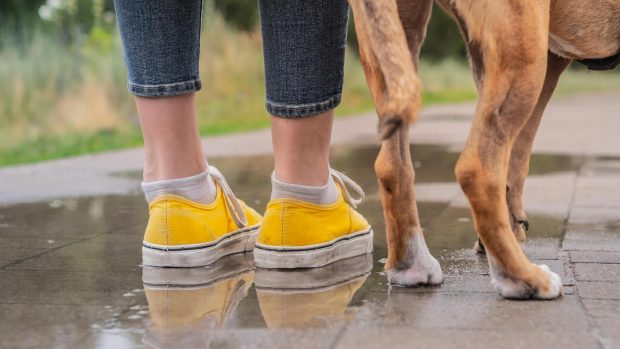There are numerous reasons why dogs shake. It can vary from being cold, excited anticipation, drying off after a dip or bath, fear, anxiety, release tension, to communicate, clean or relieve skin and ear problems, pain and illness and medical issues, sometimes old age plays a part too. We’ll go through each possible answer to “why does my dog shake?” and explain what might be happening, what you can do to help him and whether he needs to see a vet.
To dry off
You may have wondered why dogs feel the need to shake when they are wet. That shaking, however, is surprisingly efficient. Wet dogs can shake off 70% of the water on their fur in just four seconds. That is far more effective than attempts to towel dry or blow dry our dogs. Just be sure you’re not standing in the way!
Stress and anxiety
Dry dogs shake, too. If your dog gives a whole-body shake for no obvious reason, such as a bath or a good roll in the dirt, it could be stress related. Shaking is a classic sign of stress in dogs. When your dog shakes it’s usually because he’s in the presence of, or dealing with a trigger that makes him stressed and anxious. By shaking he is trying to relieve tension.
Other reasons could include loud noises, meeting strangers or other dogs, a trip to the groomers, nail clipping or even being dropped off at the kennels or a home boarding establishment.
Other signs of stress in your dog include:
- Vocalisation
- Excessive pacing
- Tucking tail
- Rigid stance
- Flat ears
- Poor appetite
- Aggression/fear aggression
If your dog seems stressed or anxious, reassure them and do your best to behave as normally as possible so your dog sees that you are not worried about any of the potential triggers that may cause the stress. I use the “Gotcha” technique. You would never leave a human in such distress, so therefore you would never allow the same for an animal. I usually put a dog behind or in-between my legs and say “Hey, I’ve gotcha” while giving them a hug or a chest rub.
If your dog remains stressed despite your best efforts, consult your vet. I have several dogs who are so anxious that they self soothe, self mutilate or exhibit OCD behaviours as a form of coping. In this case, anti-anxiety medication can help so much and allow your dog to feel less stressed and not have the constant cortisol and adrenaline running through him. More vets are now understanding the need to help dogs with such mental health conditions as opposed to just referring to a behaviourist. In some cases the dog needs both.
Cold
All dogs can feel the cold – and some more than others. Smooth coated breeds, such as ridgebacks, greyhounds, whippets or vizslas etc all need coating in cold and wet weather as they struggle to keep warm (check out our pick of the best dog coats). Young dogs struggle to regulate their temperature as do old dogs. Signs of this include tail tucking, holding their ears closer to their body, whining or the ears feeling cold to touch around the edges. They can also show signs of extreme tiredness when cold.

Ancol All Weather Coat | Amazon.co.uk
Inspired by professional outdoor pursuits clothing, this warm and waterproof coat has a cosy fleece lining to insulate your dog from the cold, plus a chest protector strap to keep them protected from puddles.

WeatherBeeta Explorer Dog Coat | Amazon.co.uk
Designed with the idea that you can go and explore anywhere, at any time. It has a waterproof ripstop polyester outer with really soft lining and a warm 160g polyfill, and a belly wrap with adjustment points for the perfect fit.
Pain
If your dog is in pain or unwell it might be that he’s actually shivering or trembling. Certain toy breeds and small terrier breeds shiver more than others. This kind of shivering can be a sign of pain. When your dog is nauseous, they may also shake. If your dog has started to shake and you don’t know why, contact your vet to make sure there isn’t a more serious issue to contend with.
Ear problems
All dog breeds can get ear infections, however some breeds are more prone including cocker spaniels, bassett hounds, Labradors or golden retrievers, so owners of these breeds should watch out for excessive head shaking. A lot of ear infections can also be avoided by feeding a diet that is more natural, rather than full of fillers, grain or yeast.
If your dog is shaking his head after a recent bath or swim, it’s quite possible that he’s suffering from an ear infection – always dry your dogs’ ears thoroughly after they’ve been in water to help prevent it. This headshaking can lead to more problems, for example, an ear haematoma (when blood accumulates in the flap of the ear) or a perforated ear drum. This will obviously require a vet visit for antibiotics, ear drops and, in some cases, sedation to flush them out. If your dog is shaking his head more than normal, check his ears to see if they appear red, inflamed, dirty or have a funny smell. If they do, take them to the vet. I always clean my dogs ears every other day to prevent wax build up and infection.
Head shaking can also be a sign of ear mites. I use Thornit ear powder (available on Viovet) regularly on my dogs as a preventive measure as well as treatment.

Thornit Ear Powder | Viovet.co.uk
This can be applied directly to the ear surface of dogs, cats, and small animals in order to treat cases of ear mites, as well as reduce symptoms and ease irritation.
Poisoning
If your dog gets hold of one of the many human products that contain xylitol, such as sugar-free gum, mints or even anti-smoking medications, they could cause trembling, seizures, vomiting, diarrhoea, and in some cases may be fatal. Chocolate, alcohol, grapes and raisins, onions, garlic and tomatoes are all poisonous to your dog, too, as is any pest control chemical that may have been put down. Call your vet immediately if you suspect your dog ingested one of these toxic items.
Low blood sugar
Shaking can be a sign of a sudden change in blood chemistry and toy dogs, small dog breeds and young puppies are most susceptible to this condition. Keeping your dog on a well-balanced diet and feeding on a routine schedule can help prevent low blood sugar.
Canine distemper
This is a virus that may cause shaking and trembling in dogs – unvaccinated dogs and puppies are most at risk. The virus is very contagious and must run its course, so the infected dog should be separated from other dogs. You must see your vet if you suspect canine distemper. They will treat the symptoms, may prescribe antibiotics to prevent secondary infections, and will suggest keeping the dog hydrated to prevent dehydration.
Age-related shaking
If an older dog has been out in the elements too long without wearing a coat or has been swimming on a cold day, they can shake for several hours as they are less able to regulate their temperature effectively. Warming them up with blankets and one of the best hot water bottles for dogs can help stop shaking.
Older dogs sometimes also develop tremors in their legs, particularly the hind ones, as they lose muscle mass when they cannot exercise as they once did. If you’re walking an older dog in cold or wet weather, I’d recommend a fleece jumper, such as an Equafleece (available on Amazon) and one of the best waterproof dog coats. Hydrotherapy can also help an older dog build and maintain muscle mass without the stress on their joints.

Equafleece Hotterdog | Amazon.co.uk
This fleece jumper is available in five sizes and a range of colours. It covers the torso, chest, belly and front legs, keeping your dog warm but with great freedom of movement.

Hotties Microhottie | Amazon.co.uk
Avoid boiling water with this microwave heat pack that heats up in the microwave and stays warm for hours, delivering gentle sustained heat for comfort and warmth.

Snugglesafe Microwave Heat Pad | Amazon.co.uk
This microwaveable heatpad (22cm across) stays warm for up to 10 hours. All you need to do is pop it in the microwave and place it in your dog’s bed.

Ancol All Weather Coat | Amazon.co.uk
Inspired by professional outdoor pursuits clothing, this warm and waterproof coat has a cosy fleece lining to insulate your dog from the cold, plus a chest protector strap to keep them protected from puddles.

WeatherBeeta Explorer Dog Coat | Amazon.co.uk
Designed with the idea that you can go and explore anywhere, at any time. It has a waterproof ripstop polyester outer with really soft lining and a warm 160g polyfill, and a belly wrap with adjustment points for the perfect fit.
Neurological conditions
Generalised Tremor Syndrome (GTS) is also known as white dog shaker syndrome. This condition, which causes full body shaking, was first noticed in small white dogs, but it has been seen in all colours and sizes. Another inherited condition, cerebellar hypoplasia affects puppies when part of their brain hasn’t fully developed and makes them wobbly on their feet. Your vet will usually prescribe corticosteroids.
Sometimes shaking is an indication of an underlying condition, such as a trapped nerve, that should be diagnosed and treated by your vet. Cramp can also make them shake and yelp. If you suspect there’s an issue, consult your vet as soon as possible.
Seizures
If your dog is violently shaking, you may fear he’s having a fit. Seizures can appear as uncontrollable shaking for several minutes, but they also manifest in other ways – muscle contractions, jerking movements, collapse, and brief loss of consciousness. If you suspect your dog has had a seizure, then get it to the vet urgently. There are a variety of causes of seizures, the most common of which is idiopathic epilepsy, which is usually treated with anticonvulsant medication.
Excitement
Sometimes, shaking can simply be a sign of happy excitement in a dog and will resolve when he is given access to the object of that excitement. That can be the owner, their favourite toy or food! Even getting a lead out ready for a walk can instigate this behaviour.
You might also like:

No need for a drip dry: the best drying coats for wet dogs

The best waterproof canine coats to keep your dog cosy and dry whatever the weather

Why does my dog eat poop?

Why is my dog eating grass?

What breed is my dog? (and why you need to know)

Subscribe to Horse & Hound magazine today – and enjoy unlimited website access all year round
Horse & Hound magazine, out every Thursday, is packed with all the latest news and reports, as well as interviews, specials, nostalgia, vet and training advice. Find how you can enjoy the magazine delivered to your door every week, plus options to upgrade your subscription to access our online service that brings you breaking news and reports as well as other benefits.





